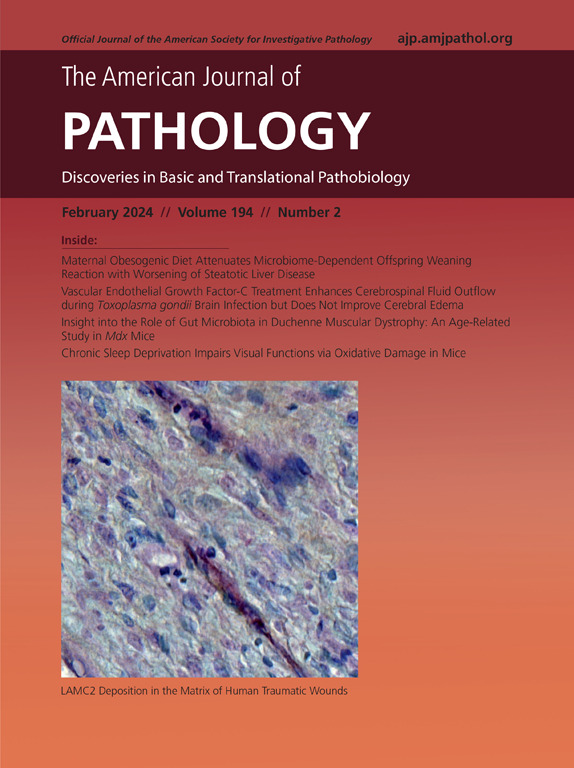Genetic Loss of HIF-Prolyl-Hydroxylase 1, but Not Pharmacological Inhibition, Mitigates Hepatic Fibrosis
IF 4.7
2区 医学
Q1 PATHOLOGY
引用次数: 0
Abstract
Liver fibrosis is characterized by excessive deposition of extracellular matrix due to chronic inflammation of the liver. Hepatic stellate cells (HSCs) become activated and produce increased amounts of extracellular matrix. Loss of HIF-prolyl-hydroxylase 1 (PHD1) attenuates HSC activation and fibrotic tissue remodeling in a murine model of biliary liver fibrosis. Herein, the protective effect of PHD1 deficiency (PHD1−/−) in an additional (toxic) model of liver fibrosis was validated and the effect of dimethyloxalylglycine (DMOG), a pan-HIF-prolyl-hydroxylase inhibitor, on the development of liver fibrosis, was evaluated. Liver fibrosis was induced utilizing carbon tetrachloride in wild-type (WT) and PHD1−/− mice treated with either vehicle or DMOG. To assess fibrosis development, expression of profibrotic genes in the livers was analyzed by Sirius red staining. When compared with WT mice, PHD1−/− mice developed less-severe liver fibrosis. DMOG treatment did not prevent this liver fibrosis. PHD1−/− mice had fewer α-SMA+ cells and less macrophage infiltration compared with WT mice. Expression of profibrogenic and proinflammatory genes was reduced in livers from carbon tetrachloride–exposed PHD1−/− mice. In vitro analyses of PHD1-deficient human HSCs revealed attenuated mRNA levels of profibrotic genes, as well as impaired migration and invasion. Although PHD1 deficiency attenuated activation of HSCs, pharmacologic PHD inhibition did not ameliorate fibrosis development. These data indicate that selective PHD1 inhibitors could prove effective in preventing and treating liver fibrosis.

基因缺失 HIF-Prolyl-Hydroxylase (PHD) 1(而非药物抑制)可减轻肝纤维化。
肝纤维化的特点是由于肝脏慢性炎症导致细胞外基质(ECM)过度沉积。造血干细胞被激活后会产生过量的 ECM。此前,我们曾发现,在小鼠胆汁性肝纤维化模型中,HIF-脯氨酰羟化酶 1(PHD1)的缺失可减轻造血干细胞的活化和纤维化组织的重塑。因此,我们在另一种(毒性)肝纤维化模型中验证了 PHD1 缺乏(PHD1-/-)的保护作用,并评估了泛 HIF-脯氨酰羟化酶抑制剂二甲基环己基甘氨酸(DMOG)对肝纤维化发展的影响。利用四氯化碳(CCl4)诱导WT、PHD1-/、车辆和DMOG处理的小鼠肝纤维化。通过天狼星红染色和促纤维化基因的基因表达分析进一步分析肝脏,以评估纤维化的发展情况。与 WT 小鼠相比,PHD1-/- 小鼠的肝纤维化程度较轻。相反,DMOG治疗并不能阻止肝纤维化。与WT小鼠相比,PHD1-/-小鼠的α SMA+细胞数量较少,巨噬细胞浸润也较少。在暴露于CCl4的PHD1-/-小鼠肝脏中,嗜碱性基因和促炎症基因的基因表达减少。对 PHD1 缺乏的人造血干细胞进行的体外分析表明,嗜纤维化基因的 mRNA 水平降低,迁移和侵袭能力受损。虽然PHD1缺乏会减弱造血干细胞的活化,但药理抑制PHD并不能改善纤维化的发展。事实证明,选择性PHD1抑制剂可有效预防和治疗肝纤维化。
本文章由计算机程序翻译,如有差异,请以英文原文为准。
求助全文
约1分钟内获得全文
求助全文
来源期刊
CiteScore
11.40
自引率
0.00%
发文量
178
审稿时长
30 days
期刊介绍:
The American Journal of Pathology, official journal of the American Society for Investigative Pathology, published by Elsevier, Inc., seeks high-quality original research reports, reviews, and commentaries related to the molecular and cellular basis of disease. The editors will consider basic, translational, and clinical investigations that directly address mechanisms of pathogenesis or provide a foundation for future mechanistic inquiries. Examples of such foundational investigations include data mining, identification of biomarkers, molecular pathology, and discovery research. Foundational studies that incorporate deep learning and artificial intelligence are also welcome. High priority is given to studies of human disease and relevant experimental models using molecular, cellular, and organismal approaches.

 求助内容:
求助内容: 应助结果提醒方式:
应助结果提醒方式:


